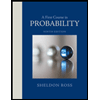
A First Course in Probability (10th Edition)
10th Edition
ISBN: 9780134753119
Author: Sheldon Ross
Publisher: PEARSON
expand_more
expand_more
format_list_bulleted
Question

Transcribed Image Text:Suppose that X and Y are random variables with E(X) = 2 , E(Y) = 5 and E(X²) = 8,
E(Y?) = 30 and cov(X – 2Y,3X – 4Y) = -12, then cov(2X – 3, –5Y + 4) is equal to:
Hint: cov(aX + bY,cx + dY) = acV(X) + bdV(Y) + (bc + ad)cov(X,Y)
-59
-120
-64
-30
Expert Solution
This question has been solved!
Explore an expertly crafted, step-by-step solution for a thorough understanding of key concepts.
This is a popular solution
Trending nowThis is a popular solution!
Step by stepSolved in 2 steps with 2 images

Knowledge Booster
Similar questions
- C2. Let X and Y be random variables, and let a and b be constants. (a) Starting from the definition of covariance, show that Cov(aX, Y): = a Cov(X, Y). You may find it helpful to remember that if EX = µx, then EaX = αμχ· (b) Show that Cov(X + b, Y) = Cov(X, Y). Now let X, Y, Z be independent random variables with common variance o². (c) Find the value of Corr(2X - 3Y + 4, 2Y – Z - 1). You may use any facts about covariance from the notes, including those from parts (a) and (b) of this question, provided you state them clearly.arrow_forwardFor two random variables X and Y, we have Var(X) = 8, Var(Y) = 4, Cov(X, Y) = -2. Find the values of the following quantities. Please show your work. (a) Cov(Y, X) (Hint: by using the definition Cov(X, Y) = E[(X – EX)(Y – EY)], observe that Cov(X, Y) = Cov(Y, X). ] (b) Cov(X, X) (Hint: by using the definition of covariance and variance, observe that Cov(X, X) = Var(X). ) (c) Var(X + Y) (Hint: use the identity Var(X + Y) = (d) Var(X + X) Var(X)+ Var(Y) + 2Cov(X, Y). ) (e) Cov(X, -X) (Hint: use the identity Cov(aX, bY) = ab · Cov(X,Y). )arrow_forward2. Let X and Y be random variables, and let a and b be constants. (a) Starting from the definition of covariance, show that Cov(aX,Y) = a Cov(X,Y). You may find it helpful to remember that if EX = µx, then EaX = aux. (b) Show that Cov(X + b, Y) = Cov(X,Y). Now let X, Y, Z be independent random variables with common variance o?. (c) Find the value of Corr(2X – 3Y + 4, 2Y – Z – 1). You may use any facts about covariance from - the notes, including those from parts (a) and (b) of this question, provided you state them clearly.arrow_forward
- 18. Suppose X and Y are random variables with E (X) = 2 E (Y) = 3 E (X*) = 53 E (Y*) = 45 E (XY) = -21 (a) Find V (X) (b) Find V (Y) (c) Find Cov(X, Y) (d) Find V (2X –- 3Y')arrow_forwardSuppose that X is a random variable which takes values in the set {1, 2, 3}. If P(X = 1) = 0.2 and E(X) = 2, determine the fourth moment E(X4). Answer:arrow_forwardLet W = 2X + 5Y – 3Z, where the random variables X, Y, and Z satisfy E(X)= 2, V(X)= 5, E(Y)= -3, V(Y)=4, E(Z)=7, V(Z) = 6, Cov(X,Y) = -1, Cov(Y, Z) =3, Cov(Z, X)= 2. Calculate E(W), V (W) and Cov(W, Y).arrow_forward
- Suppose that X and Y are random variables with E(X) = 1, E(X²) = 5, E(Y) = 3, and E(XY) = 1. Match up the following quantities. Cov(X,Y) Corr(X, Y) Var(-X/2) Cov(X/2,-2Y + 3) Drag answer here Cannot be determined Drag answer here Drag answer here 2 Cannot be determined 1arrow_forwardI roll a die with 10 faces numbered 0-9 and obtain a score X. What is E(X)? In order to obtain a random number between 0 and 99 I roll the die twice obtaining scores X and Y, then set Z = 10X + Y (i.e., the first roll determines the "tens", the second roll the "ones"). Is it true to say that E(Z) = 10E(X) + E(Y)?arrow_forward
arrow_back_ios
arrow_forward_ios
Recommended textbooks for you
 A First Course in Probability (10th Edition)ProbabilityISBN:9780134753119Author:Sheldon RossPublisher:PEARSON
A First Course in Probability (10th Edition)ProbabilityISBN:9780134753119Author:Sheldon RossPublisher:PEARSON

A First Course in Probability (10th Edition)
Probability
ISBN:9780134753119
Author:Sheldon Ross
Publisher:PEARSON
